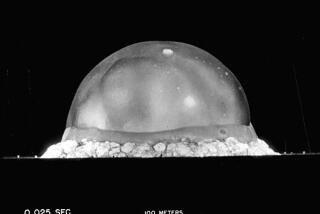Let there be enlightenment
- Share via
Alump of uranium seems an unpromising place to look for God. But in this lethal material Owen Gingerich, an emeritus professor of astronomy at Harvard University, detects a signature of divine action in the world. In his slim and elegant new book, “God’s Universe,” Gingerich finds that indeed everywhere he looks he can discern the hand of a benevolent Creator -- all without compromising his adherence to a rigorous methodological scientific naturalism.
Take the uranium. Curiously, Gingerich writes, “in the cosmos as a whole gold is at least ten times more common than uranium, but here at the surface of the earth uranium is about five hundred times more abundant than gold.” The reason is that uranium is radioactive and gives off heat in Earth’s interior, generating slow convection currents that carry the element up to the surface. This convection has been crucial in the development of life on Earth, for “over hundreds of millions of years it helps build the continental zones [and] gives rise to continental drift.”
Remarkably, the half-life of uranium (a measure of its rate of decay) is 4.5 billion years, which is also the age of the Earth. Were its half-life much longer, Gingerich tells us, uranium would not produce nearly so much heat, hence our planet would be less geologically active; were it shorter, most of the Earth’s uranium would be gone by now and the mantle would be correspondingly quiescent. In sum, the half-life of uranium seems curiously timed to create conditions that have made our planet hospitable to life.
In “God’s Universe,” Gingerich recounts many other examples of the ways in which the universe as a whole, and our planet in particular, seems suspiciously primed for life. Our atmosphere, for example, has just enough oxygen to sustain fire but not enough to be explosive. Oxygen is critical to the process by which our cells are fueled, and it is fortunate that we have a ready supply of it. Fortunate too that our universe is well stocked with carbon. All life we know of is based on carbon, whose chemical properties allow for an astonishing variety of molecular couplings, from the hemoglobin that transports the oxygen in our blood to the DNA that bears our genetic code. As Voltaire’s Pangloss famously remarked, we appear to live in the best of all possible worlds. What is the cause of this extraordinary good fortune? For Gingerich, the most plausible explanation is that a benevolent power has shaped a world to enable life to come into being.
Gingerich is an astronomer whose research focused for many years on identifying stars that made the heavier elements, such as uranium. He is also a renowned historian of science and especially expert on the work of Nicolaus Copernicus. Like Charles Darwin, Copernicus is often accused by Christians of having removed humankind from the center of the cosmos, thus diminishing us in the eyes of God. Gingerich does not accept this view. As a practicing Christian in the Anabaptist tradition -- his father’s four great-grandfathers were all Amish ministers -- he wishes to defend the modern scientific world picture not just as a scientist but also as a man of faith. An underlying theme of the three essays that make up the core of this book is “how to take both science and the Bible seriously.”
Taking the Bible seriously does not have to mean interpreting it literally. Indeed, Gingerich deplores this approach to Scripture. He notes the inconsistency of the biblical literalists in accepting the fruits of science while rejecting the principles on which these achievements depend. “Folks who take in stride the modern technology of cell phones, laser scanners, airplanes, and atomic bombs,” he writes, “nevertheless show reluctance to accept the implications of the science that lies behind these awesome inventions” -- specifically, the long age of the universe required to produce the necessary materials: uranium, silicon and other complex atomic elements.
Gingerich is clearly no advocate for the “Intelligent Design” movement. Yet he does not find naturalistic materialism a plausible explanation for how things have come to be as they are. To him, as a scientist, the universe suggests something other than blind chance or pure luck. He writes that he believes in intelligent design (lowercase) and in a God who works with natural laws. He notes correctly that materialism is itself a metaphysical presupposition and not (as too many of its proponents suggest) a scientific fact. By shoving materialism down our throats and insisting that the discoveries of science admit of no other interpretation, the evolutionary biologist Richard Dawkins “single-handedly makes more converts to Intelligent Design” than any of its leading theorists.
Quite so! And that is why -- despite the fact that as an atheist I do not see the hand of God in the universe -- I found myself cheering for this lucid and poetic little book. Let us not forget that atheism is also a faith position -- something beyond the bounds of scientific proof. One can be quite consistently a methodological naturalist (that is, a scientist in the modern sense) and a theist. Gingerich is right to stress that many great scientists have chosen this path, among them Copernicus and Newton.
In this time of sectarian wars, when theists and atheists are engaged in increasingly hostile incivilities, Gingerich lays out an elegant case for why he finds the universe a source of encouragement for his life both as a scientist and as a Christian. We do not have to agree with his conclusions to be buoyed and enchanted by the journey on which he takes us. *






